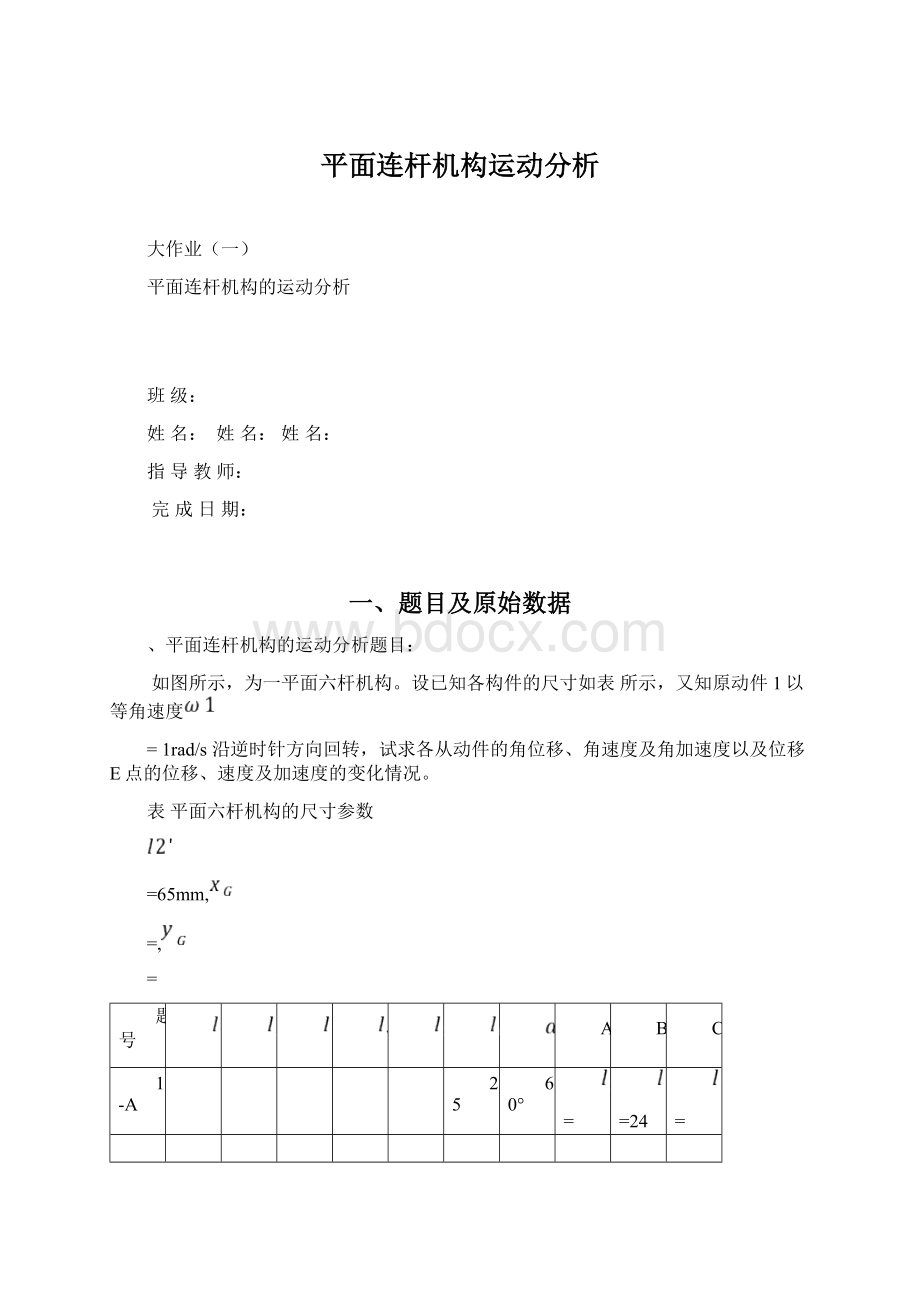平面连杆机构运动分析.docx
《平面连杆机构运动分析.docx》由会员分享,可在线阅读,更多相关《平面连杆机构运动分析.docx(28页珍藏版)》请在冰豆网上搜索。

平面连杆机构运动分析
大作业
(一)
平面连杆机构的运动分析
班级:
姓名:
姓名:
姓名:
指导教师:
完成日期:
一、题目及原始数据
、平面连杆机构的运动分析题目:
如图所示,为一平面六杆机构。
设已知各构件的尺寸如表所示,又知原动件1以等角速度
=1rad/s沿逆时针方向回转,试求各从动件的角位移、角速度及角加速度以及位移E点的位移、速度及加速度的变化情况。
表平面六杆机构的尺寸参数
=65mm,
=,
=
题号
A
B
C
1-A
25
60°
=
=24
=
要求每组(每三人为一组,每人一题)至少打印一份源程序,每个同学计
算出原动件从0º到360º时(计算点数N=36)所要求各运动变量的大小,并绘出各组应的运动线图以及E点的轨迹曲线。
图
二、平面连杆机构运动分析方程
、位移方程:
、速度方程:
、加速度方程:
三、计算程序框图
四、计算源程序
主程序
%输入已知数据
clear
l1=;
l2=;
l3=;
l4=;
l5=;
l6=;
l22=;
xg=;
yg=;
omega1=1;
alph1=0;
hd=pi/180;
du=180/pi;
t1=1:
10:
361;
theta2=1:
10:
361;
theta3=1:
10:
361;
theta5=1:
10:
361;
theta6=1:
10:
361;
omega2=1:
10:
361;
omega3=1:
10:
361;
omega5=1:
10:
361;
omega6=1:
10:
361;
alph2=1:
10:
361;
alph3=1:
10:
361;
alph5=1:
10:
361;
alph6=1:
10:
361;
xe=1:
10:
361;
ye=1:
10:
361;
V=1:
10:
361;
a=1:
10:
361;
theta1=0;
options=gaoptimset('PopulationSize',100,'Generations',10000,'StallGenLimit',500,'TolFun',1e-100);
theta0=ga(@(thet)weiyi_0(thet,theta1),4,options);
iftheta0
(1)<0
theta0
(1)=theta0
(1)+2*pi;end
iftheta0
(1)>2*pi
theta0
(1)=theta0
(1)-2*pi;end
iftheta0
(2)<0
theta0
(2)=theta0
(2)+2*pi;end
iftheta0
(2)>2*pi
theta0
(2)=theta0
(2)-2*pi;end
iftheta0(3)<0
theta0(3)=theta0(3)+2*pi;end
iftheta0(3)>2*pi
theta0(3)=theta0(3)-2*pi;end
iftheta0(4)<0
theta0(4)=theta0(4)+2*pi;end
iftheta0(4)>2*pi
theta0(4)=theta0(4)-2*pi;
end
%调用子函数Fun_jixie计算该六杆机构的各杆角位移、角速度、角加速度以及E点的角位移、角速度、角加速度
forn1=1:
10:
361
theta1=(n1-1)*hd;
t1(n1)=theta1*du;
theta=fsolve(@(thet)weiyi(thet,theta1),theta0);
iftheta
(1)<0
theta
(1)=theta
(1)+2*pi;end
iftheta
(1)>2*pi
theta
(1)=theta
(1)-2*pi;end
iftheta
(2)<0
theta
(2)=theta
(2)+2*pi;end
iftheta
(2)>2*pi
theta
(2)=theta
(2)-2*pi;end
iftheta(3)<0
theta(3)=theta(3)+2*pi;end
iftheta(3)>2*pi
theta(3)=theta(3)-2*pi;end
iftheta(4)<0
theta(4)=theta(4)+2*pi;end
iftheta(4)>2*pi
theta(4)=theta(4)-2*pi;end
[xe(n1),ye(n1)]=weiyi_E(theta1,theta,l1,l2,l22);
[omega,alph]=Fun_jixie(theta1,omega1,l1,l2,l3,l5,l6,l22,theta);
[V(n1),a(n1)]=sudu_jasudu_E(omega
(1),alph
(1),theta,theta1,omega1,l1,l2,l22,alph1);theta2(n1)=theta
(1);theta3(n1)=theta
(2);theta5(n1)=theta(3);theta6(n1)=theta(4);omega2(n1)=omega
(1);omega3(n1)=omega
(2);omega5(n1)=omega(3);omega6(n1)=omega(4);
alph2(n1)=alph
(1);alph3(n1)=alph
(2);alph5(n1)=alph(3);alph6(n1)=alph(4);
theta0=theta;
end
%绘制各杆件的角位移、角速度、角加速度
n2=1:
10:
361;
n1=1:
10:
361;
figure
(1);%%%%%%
subplot(2,2,1)%绘制位移线图
plot((n1-1),theta2(n2)*du,'r-',(n1-1),theta3(n2)*du,'g-',(n1-1),theta5(n2)*du,'y-',(n1-1),theta6(n2)*du,'k-','LineWidth',;
title('各杆角位移线图');
xlabel('原动件1\theta_1/\circ');
ylabel('角位移/\circ');
gridon;holdon;
text(200,60,'θ2');
text(200,150,'θ3');
text(200,350,'θ5');
text(200,260,'θ6');
%%%%%%
subplot(2,2,2)%绘制角速度线图
plot((n1-1),omega2(n2),'r-',(n1-1),omega3(n2),'g-',(n1-1),omega5(n2),'y-',(n1-1),omega6(n2),'k-','LineWidth',;
title('各杆角速度线图');
xlabel('原动件1\theta_1/\circ');
ylabel('角速度/rad\cdots^{-1}');
gridon;holdon;
%%%%%%
subplot(2,2,3)%绘制角加速度线图
plot((n1-1),alph2(n2),'r-',(n1-1),alph3(n2),'g-',(n1-1),alph5(n2),'y-',(n1-1),alph6(n2),'k-','LineWidth',;
title('各杆角加速度线图');
xlabel('原动件1\theta_1/\circ');
ylabel('角加速度/rad\cdots^{-2}');
gridon;holdon;
%%%%%%%
%求E点的位移
figure
(2)
subplot(2,2,1)
plot(xe(n1),ye(n1),'r-','LineWidth',;
title('E的位移线图');
xlabel('E在x方向位移');
ylabel('E在y方向位移');
gridon;holdon;
%求E点角速度与角加速度
subplot(2,2,2)%绘制E点角速度
plot((n1-1),V(n1),'r-','LineWidth',;
title('E点角速度');
xlabel('原动件1\theta_1/\circ');
ylabel('E点角速度/rad\cdots^{-1}');
gridon;holdon;
subplot(2,2,3)%绘制E点角加速度
plot((n1-1),a(n1),'r-','LineWidth',;
title('E点角加速度');
xlabel('原动件1\theta_1/\circ');
ylabel('E点角加速度/rad\cdots^{-2}');
gridon;holdon;
%将数据输出到Exel表中
xlswrite('E:
\机械原理大作业\平面六杆机构\Matlab程序\',t1(n1)','sheet1','A1');
xlswrite('E:
\机械原理大作业\平面六杆机构\Matlab程序\',theta2(n1)'*du,'sheet1','B1');
xlswrite('E:
\机械原理大作业\平面六杆机构\Matlab程序\',theta3(n1)'*du,'sheet1','C1');
xlswrite('E:
\机械原理大作业\平面六杆机构\Matlab程序\',theta5(n1)'*du,'sheet1','D1');
xlswrite('E:
\机械原理大作业\平面六杆机构\Matlab程序\',theta6(n1)'*du,'sheet1','E1');
xlswrite('E:
\机械原理大作业\平面六杆机构\Matlab程序\',omega2(n1)','sheet1','F1');
xlswrite('E:
\机械原理大作业\平面六杆机构\Matlab程序\',omega3(n1)','sheet1','G1');
xlswrite('E:
\机械原理大作业\平面六杆机构\Matlab程序\',omega5(n1)','sheet1','H1');
xlswrite('E:
\机械原理大作业\平面六杆机构\Matlab程序\',omega6(n1)','sheet1','I1');
xlswrite('E:
\机械原理大作业\平面六杆机构\Matlab程序\',alph2(n1)','sheet1','J1');
xlswrite('E:
\机械原理大作业\平面六杆机构\Matlab程序\',alph3(n1)','sheet1','K1');
xlswrite('E:
\机械原理大作业\平面六杆机构\Matlab程序\',alph5(n1)','sheet1','L1');
xlswrite('E:
\机械原理大作业\平面六杆机构\Matlab程序\',alph6(n1)','sheet1','M1');
xlswrite('E:
\机械原理大作业\平面六杆机构\Matlab程序\',V(n1)','sheet1','N1');
xlswrite('E:
\机械原理大作业\平面六杆机构\Matlab程序\',a(n1)','sheet1','O1');
从动件角位移,角速度,角加速度
function[omega,alph]=Fun_jixie(theta1,omega1,l1,l2,l3,l5,l6,l22,theta)
%从动件角位移
theta2=theta
(1);theta3=theta
(2);theta5=theta(3);theta6=theta(4);
%%%%%%
%计算从动件角速度
A=[-l2*sin(theta2),l3*sin(theta3),0,0;
l2*cos(theta2),-l3*cos(theta3),0,0;
-l22*sin(theta2-pi/3),-l3*sin(theta3),-l5*sin(theta5),l6*sin(theta6);
l22*cos(theta2-pi/3),l3*cos(theta3),l5*cos(theta5),-l6*cos(theta6)];
B=[l1*sin(theta1);-l1*cos(theta1);0;0];
omega=A\(omega1*B);
omega2=omega
(1);omega3=omega
(2);omega5=omega(3);omega6=omega(4);
%%%%%
%计算角从动件角加速度
A=[-l2*sin(theta2),l3*sin(theta3),0,0;
l2*cos(theta2),-l3*cos(theta3),0,0;
-l22*sin(theta2-pi/3),-l3*sin(theta3),-l5*sin(theta5),l6*sin(theta6);
l22*cos(theta2-pi/3),l3*cos(theta3),l5*cos(theta5),-l6*cos(theta6)];
At=[-l2*omega2*cos(theta2),l3*omega3*cos(theta3),0,0;
-l2*omega2*sin(theta2),l3*omega3*sin(theta3),0,0;
-l22*omega2*cos(theta2-pi/3),-l3*omega3*cos(theta3),-l5*omega5*cos(theta5),l6*omega6*cos(theta6);
-l22*omega2*sin(theta2-pi/3),-l3*omega3*sin(theta3),-l5*omega5*sin(theta5),l6*omega6*sin(theta6)];
Bt=[omega1*l1*cos(theta1);omega1*l1*sin(theta1);0;0;];
alph=A\(-At*omega+omega1*Bt);
end
点角速度,角加速度
function[V,a]=sudu_jasudu_E(omega,alph,theta,theta1,omega1,l1,l2,l22,alph1)
%求E点角速度
A=[-l1*sin(theta1),-l2*sin(theta
(2))+l22*sin(pi/3-theta
(1));l1*cos(theta1),l2*cos(theta
(1))-l22*cos(pi/3-theta
(1))];
B=[omega1;omega
(1)];
Vx=-l1*sin(theta1)*omega1-l2*sin(theta
(2))+l22*sin(pi/3-theta
(1))*omega
(1);
Vy=l1*cos(theta1)*omega1+l2*cos(theta
(1))-l22*cos(pi/3-theta
(1))*omega
(1);
V=sqrt(Vx^2+Vy^2);
%求E点角加速度
D1=[alph1;alph
(1)];
D2=[-l1*cos(theta1)*omega1,-l2*cos(theta
(1))*omega
(1)-l22*cos(pi/3-theta
(1))*omega
(1);-l1*sin(theta1)*omega1,-l2*sin(theta
(2))*omega
(1)+l22*sin(pi/3-theta
(1))*omega
(1)];
a1=A*D1+D2*B;
a=sqrt(a1
(1)^2+a1
(2)^2);
end
E点位移
function[xe,ye]=weiyi_E(theta1,theta,l1,l2,l22)
xe=l1*cos(theta1)+l2*cos(theta
(1))+l22*cos(pi/3-theta
(1));
ye=l1*sin(theta1)+l2*sin(theta
(2))+l22*sin(pi/3-theta
(1));
end
五、计算结果
1-C
各杆角位移变化
主动杆1
从动杆2
从动杆3
从动杆5
从动杆6
/(°)
0
10
20
30
40
50
60
70
80
90
100
110
120
130
140
150
160
170
180
190
200
210
220
230
240
250
260
270
280
290
300
310
320
330
340
350
360
各杆角加位移变化
主动杆1
从动杆2
从动杆3
从动杆5
从动杆6
/(°)
/(rad/s)
0
10
20
30
40
50
60
70
80
90
100
110
120
130
140
150
160
170
180
190
200
210
220
230
240
250
260
270
280
290
300
310
320
330
340
350
360
各杆角加位移变化
主动杆1
从动杆2
从动杆3
从动杆5
从动杆6
E点速度
E点加速度
/(°)
/(rad/s²)
/(rad/s)
/(rad/s²)
0
10
20
30
40
50
60
70
80
90
100
110
120
130
140
150
160
170
180
190
200
210
220
230
240
250
260
270
280
290
300
310
320
330
340
350
360
1-A
各杆角位移变化:
主动杆1从动杆2从动杆3从动杆5从动杆6角速度变化:
主动杆1从动杆2从动杆3从动杆5从动杆6角加速度变化:
从动杆2从动杆3从动杆5从动杆6E点速度E点加速度
0
10
20
30
40
50
60
70
80
90
100
110
120
130
140
150
160
170
180
190
200